Provence / Côte d'Azur
The Provence is part of the region Provence-Alpes-Côte d'Azur. It is still the most popular part of the south of France. The infrastructure here is very well developped. It has wonderful beaches and many cultural attractions. Some of them will be mentioned below. When you think of the Provence, you think of lavender, medieval towns, cicades crackling in the warm Summer sun and beautiful sea views. When you think of the Côte d'Azur, you think of the surreal blue water of the Mediterranean, harbours full of yachts, long beaches, fried fish and salad for lunch, the smell of a good suntan lotion and walking through the old streets of a town with its many souvenir shops. You think of surrealistic art paintings created around 1900 by world famous artists, who picked this area for its light, its colours and its beauty. A vacation in this provence of France, either with your car, caravan or camper, is an experience of scent, colour, flavour and sound. And this is why the Provence / Côte d'Azur has become the south of France.
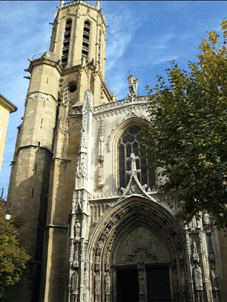 Aix-en-Provence
Aix-en-Provence
This old capital of the Provence is situated about 20 miles north of Marseille. The prosperity this town has had in the past, can still be seen. The beautiful palaces from the 17th and 18th century and the many art treasures which are displayed in the various museums, say it all. In Roman times, Aix was famous for its healing waters. This was also the origin of the name Aix (aqua = water). The name of this town therefore means: The Waters in the Provence.
History
The Roman Aquae Sextiae was founded in 121 B.C.E. by Caius Sextius, just before the destruction of the nearby Celtic-Ligurian village near Entremont. The location of Aix on the Via Aurelia, the road to Spain and the presence of the healing waters, guaranteed a long prosperity. However, during these prosperous times there was the Saracene conquest and the unrest during the migration of nations. Eventually, Aix-en-Provence became the capital of the Provence.
During the period of art lover René d'Anjou (1409-1480), Aix became a centre of literature and poetry. In 1409, the university was founded. In 1481 Aix became the property of the French crown, but during the Wars of Religion, Aix took quite a beating. In the 17th and 18th centuries, beautiful palaces were built, but the rise of the harbour city of Marseille caused a slight decline. Nevertheless, Aix was able to remain prosperous, today largely thanks to tourism.
Sites
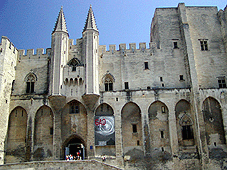 Avignon
Avignon
This town, which is enclosed by massive walls, was founded by the Romans and given the name of Avennio. Later on it fell into the hands of the Burgundians and Franks. In the 13th century, Avignon and the rest of the Provence was the possession of Count Charles of Anjou. At the time of the crusades against the Cathars (early 13th century), the town chose to side against the counts of Toulouse, who protected the Cathars. Consequently, Avignon was taken by Louis VIII in 1226. In 1348, Avignon was bought by the Pope. It now became a place of refuge and exile for several Popes, such as Urban V and John XXII. During the great schism (when two religious visions are created from one original vision), the so called "anti-popes" stayed in Avignon until 1403. In this first period, the palace was enlarged. Avignon also attracted several great Italian painters who served the Pope. All in all the town benefitted greatly from the presence of the Popes and Avignon and surroundings remained papal property until the French Revolution.
Sites
Not far from the palace we find the Cathedral Notre Dame des Doms, which was built in the 12th century, but enlarged between the 14th and 16th century. Inside you can see the 12th century bisshop's throne in white marble. The original Papal Palace of the 14th century is now the home of the Musée du Petit Palais. The gothic building which looks more like a fortress than a palace, features the famous Campana Collection of 13th to 15th century masters, and a collection of paintings from the Avignon school. It is an absolute 'must' to visit this museum, and to take your time to enjoy it.
North of the Petit Palais you will see a gate in the city wall, the Porte du Rocher, through which you can reach the famous Pont St. Benézet (known from the song "sur le pont d'Avignon"). Apart from the impressive Palais des Papes, the city wall and the medieval streets, the most famous attraction of Avignon is this bridge, which was built between 1177 and 1185. It was partly distroyed in 1668. Of the 22 arches only 4 remain.
On the busy Place de l'Horloge we find the Town Hall from 1845 and the 14th century bell tower.
Not far from the square, we find the most important museum of Avignon, Musée Calvet, where you can admire an impressive collection of antiquities, statues and paintings.
Other interesting museums:
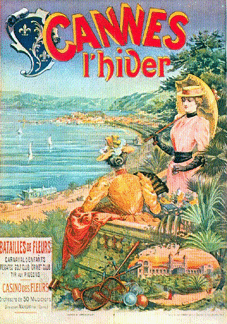 Cannes
Cannes
History
Cannes started out as a Celtic-Ligurian settlement called Aegitna, built on Mont Chevalier. The Romans are supposed to have built a fort here which they named Castrum Marsellinum. In the 4th century, St. Honorat founded a monastery on one of the islands off the coast. In the 10th century, Cannes belonged to this monastery. When the Saracene threat was felt, they started to build a stronghold to protect the town from being attacked. In the 11th century they built a look out tower. Around this tower, a new settlement was built. Because of the presence of cane along the shoreline, it was named Canois, which eventually became Cannes.
It wasn't until the 19th century, that Cannes was discovered by Lord Brougham, who came to Nice to escape the cholera epidemic. He fell in love with the little town and in 1838 a harbour was built. The sea promenade was built 30 years later.
Sites
The ancient part of Cannes lies on the slopes of Mont Chevalier. Here we find the Musée de la Castre with its archaeological collection, found in the surrounding area. From the 11th century look out tower (22 meters high) you have a wonderful view. On top of the hill we find the Eglise Notre Dame de Pérance from the 17th century. In the sacristy we see a beautiful wooden statue of the mother of Mary, Ste. Anna, from the 15th century. At the entrance you can see a small left over from the old city wall.
When you walk down towards the harbour, you find terraces, restaurants, souvenir shops, palace like hotels, expensive shops and the Promenade de la Croissette with its many palm trees. The Palais des Festivals is where the annual film festival of Cannes is held.
Of course it is wonderful on the beautiful beaches when it is nice and hot. In the peak season it can therefore be very crowded on the beaches. It is advisable to arrive early in the morning so you can park your car.
In Golfe Juan, Napoleon landed on the mainland after his exile on Elba.
Antibes was founded by the Greek. Many rich Europeans live here in their expensive villa's.
Grasse
Visiting the Côte d'Azur without visiting this centre of the perfume industry would be incomplete. Find out all about perfume making and also visit the 12th century cathedral, where you can see two paintings of Pieter Paul Rubens.
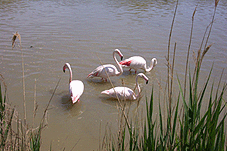 The Camarque
The Camarque
South of Arles lies an enormous delta, formed by the mouths of the rivers Petite Rhône, the Grand Rhône and the Mediterranean. This is the area of the flamingo's, the little white semi-wild horses and black bulls.
There are several horse farms where you can ride on the white horses of the Camarque and explore this beautiful natural area. It is unknown where these horses came from. They can be born dark, and become white when they grow up. The horses are never inside. They need to be able to live in natural conditions, both in the hot sun during Summer, or in the sharp cold winds of Winter. The gardiens of the horses and bulls of the Camarque live in a special community. Their traditional houses are called Cabanes. These houses have caned roofs and no windows. Above the door are the horns of a bull to keep out evil. Actually, they are still oldfashion cowboys, who keep the tradition of the old Camarque alive.
On the road to Stes Maries de la Mèr you will pass the Musée Carmarguais, where you can see some of the traditions of the people of the Camarque.
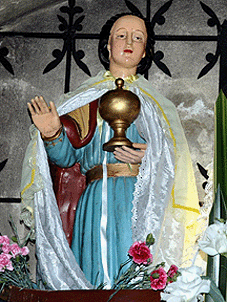 Stes. Maries de la Mèr is the capital of the Camarque. This place has been named after the 3 Mary's who, according to legend, were washed ashore or shipwrecked in or around 44 AD and lived on to preach Christianity in southern France. The most important saint however, is Sarah, the patron saint of the gypsies. The reality behind the legend may be found in the arrival of several important (perhaps even royal) families from Palestine around 44 AD. Already in earlier times, Essenes and after that, Essene and gnostic Christians fled to the Mediterranean coast of southern France, the Provence and the Languedoc, to escape the unrest and violence of their homeland. This coast of France therefore became a safe haven for both Jews, Essenes and Nazareens (a Jewish word for non-Jews). It is quite possible that several people from the New Testament were among them and founded new communities in this area. They may have spread an early form of gnostic Christianity, which could well be the basis for the later Cathar beliefs. That is why this part of France had such a unique culture at the time, while the rest of Europe was still in the Dark Ages. Provence and Languedoc knew prosperity and riches, science and art. From the early Middle Ages, Stes. Maries de la Mèr is a holy place, where Biblical figures stept on French soil.
Stes. Maries de la Mèr is the capital of the Camarque. This place has been named after the 3 Mary's who, according to legend, were washed ashore or shipwrecked in or around 44 AD and lived on to preach Christianity in southern France. The most important saint however, is Sarah, the patron saint of the gypsies. The reality behind the legend may be found in the arrival of several important (perhaps even royal) families from Palestine around 44 AD. Already in earlier times, Essenes and after that, Essene and gnostic Christians fled to the Mediterranean coast of southern France, the Provence and the Languedoc, to escape the unrest and violence of their homeland. This coast of France therefore became a safe haven for both Jews, Essenes and Nazareens (a Jewish word for non-Jews). It is quite possible that several people from the New Testament were among them and founded new communities in this area. They may have spread an early form of gnostic Christianity, which could well be the basis for the later Cathar beliefs. That is why this part of France had such a unique culture at the time, while the rest of Europe was still in the Dark Ages. Provence and Languedoc knew prosperity and riches, science and art. From the early Middle Ages, Stes. Maries de la Mèr is a holy place, where Biblical figures stept on French soil.
Still, on 22nd October, the shrines of the saints are taken from the church and brought to the sea where they came from, and then the bisshop blesses the water.
For the gypsies, Stes. Maries is a magical centre, where the holy Sarah rests, their patron saint. On 24th and 25th May they will hold a procesison here. And once every 4 years, a new Gypsy Queen is chosen.
A visit to the 12th century fortified church is an absolute 'must'. The church was fortified when Moorish pirates made the coastline unsafe. Do take the trouble of climbing the roof, as you will be rewarded with stunning views. In the church, you will see Ste. Sarah and the boat which is carried to sea during the procession.
The Musée Baroncelli is worth a visit as well; here you will learn all about the Camarque.
From Les Saintes Maries de la Mèr you can make excursions through the camarque on horseback or by boat. More information, visit the tourist office (Sindicat d'Initiative).
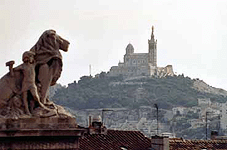 Marseille was founded by the Greek in the 7th century B.C.E. In 49 B.C.E., the Romans arrived. Massilia quickly grew to become "the Port to the West" and became an important trade harbour. Even today, Marseille is the largest trade harbour of France and has strong connections to the Middle-East and Africa. In the original, old harbour, which became too small for the larger ships, only little ships can be found.
Marseille was founded by the Greek in the 7th century B.C.E. In 49 B.C.E., the Romans arrived. Massilia quickly grew to become "the Port to the West" and became an important trade harbour. Even today, Marseille is the largest trade harbour of France and has strong connections to the Middle-East and Africa. In the original, old harbour, which became too small for the larger ships, only little ships can be found.
The city has 2 faces. There is the busy cosmopolitan and the old town with its many sites. Visit the tourist office (Sindicat d'Initiative) before you explore the centre. Here you can also get information on boat trips to e.g. Cassis. However, you can also drive to Cassis and make a boat trip to Marseille from there to avoid the crowded streets and car parks, especially in high Summer.
Sites
The Notre-Dame-de-la-Garde is a neo-Byzantine basilica, built between 1853 and 1864. The church dominates the city and on top of the 16 meter high clock tower you can see a statue of Mary. The interior is beautifully decorated with panels of marble and mosaics.
Off the coast you can see a rocky island with its famous prison, Chateau d'If. It was built in 1524 for the artillery, but was never really used for military purposes. It was, however, used as a prison. It inspired Alexandre Dumas to write his world famous novel "The Count of Monte Cristo".
Le Vieux Port is the old harbour of Marseille. Until the 19th century this was the original Greek harbour and the centre of the trade. Today it is a yacht and fishing harbour.
Other sites
Cassis has kept its unique atmosphere as a traditional fishing village. You can take a lovely boat trip along the coastline.
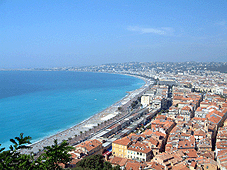 Nice is the largest seaside town on the Mediterranean. This town was originally founded by the Greek and colonised by the Romans.
Nice is the largest seaside town on the Mediterranean. This town was originally founded by the Greek and colonised by the Romans.
In the 19th century, the famous "Promenade des Anglais" was built. This is the 5 km long road with shops, old hotels and galeries. You can take a tourist train through Nice, which, with 15 minute stops, will go all the way up the hill. From here you have a wonderful view. On the hill, you will find the remains of the Roman baths and an amphitheatre.
Nimes
The old town of Nemausus was the capital of a Celtic tribe, the Volcae Arecomici, who built their city around a holy well. In 121 B.C.E. the Romans arrived, after which Nemausus changed into one of the most important cities in Gaul. This is mainly thanks to its location on the Roman road from Italy to Spain. The remains of this period are silent witnesses to this impressive past. The town was called Colonia Augusta Nemausensis. Emperor August's son-in-law, Agrippa, had a temple and public baths built. The temple is known as the Maison Carrée. A copy of this temple was built in the centre of Paris by Napoleon, and named La Madeleine. Napoleon probably did this to link the ancient Roman temple to Mary Magdalene, who may have spread an early form of gnostic Christianity from this temple in Nimes.
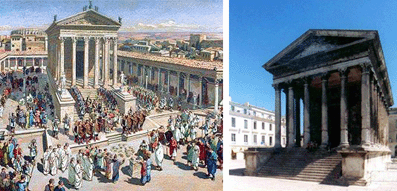
During the Middle Ages, Nemausus was ruled by its own counts. In 1185 the city became the property of the Counts of Toulouse. The largely protestant town suffered greatly during the Religous Wars and again in 1701, during the Huguenot rise in the Cevennes.
The most important site in Nimes is the Roman amphitheatre in the centre of town. It was built in the 1st century AD and has a capacity of 21.000 people. Therefore it is perhaps not one of the largest amphitheatres of Roman Gaul, but most certainly one of the best kept Roman remains of Europe.
At the foot of Mont Cavalier you find the 18th century Jardin de la Fontaine, where you can sit in the shade of the trees and enjoy watching the flowing waters of the fountain, the Diana temple, the Tour Magne and the ancient baths.
The cathedral of Notre Dame et St. Castor was augurated in 1096 by Pope Urban II. In the same year there was the first crusade to Palestine.
Close to the cathedral, you see the old Bisshop's Palace, with the Musée du Vieux Nimes. Opposite the cathedral you will see the Tour de l'Horloge.
There are several interesting museums, such as the Archaeological Museum and the Museum of Fine Arts.
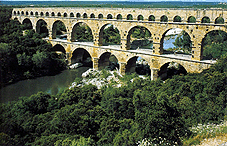 Not far from Nimes, in a beautiful natural spot, stands a miracle of Roman architecture, the Pont du Gard. From here you have a lovely view over the surrounding area. The aquaduct was built just before the first century and is 50 km long. From the top floor you will be 49 meters above the river Gardon. When you walk towards the other river bank, you will have the best view of the bridge.
Not far from Nimes, in a beautiful natural spot, stands a miracle of Roman architecture, the Pont du Gard. From here you have a lovely view over the surrounding area. The aquaduct was built just before the first century and is 50 km long. From the top floor you will be 49 meters above the river Gardon. When you walk towards the other river bank, you will have the best view of the bridge.
 When the Côte d'Azur was developped for tourism, St. Tropez was forgotten, mainly because of its position further north. This saved the town from being overdevelopped, and therefore it could largely maintain its original character. The painter Paul Signac discovered St. Tropez and her charm in 1892. It is usually painters and writers who made the best promotion for a particular place in that period. In Signac's footsteps, many other painters and writers came, and they attracted lots of rich and famous people. And these attracted, in their turn, even more rich and famous people to St. Tropez. It soon became the spot to spot the stars.
When the Côte d'Azur was developped for tourism, St. Tropez was forgotten, mainly because of its position further north. This saved the town from being overdevelopped, and therefore it could largely maintain its original character. The painter Paul Signac discovered St. Tropez and her charm in 1892. It is usually painters and writers who made the best promotion for a particular place in that period. In Signac's footsteps, many other painters and writers came, and they attracted lots of rich and famous people. And these attracted, in their turn, even more rich and famous people to St. Tropez. It soon became the spot to spot the stars.
In the Second World War, the town was badly damaged, but in the fifties of the 20th century, St. Tropez was again in the news when the films with Brigitte Bardot were recorded here. Soon, mass tourism flocked to its famous beach and today, expensive yachts can be seen in the harbour, and people are still spotting the stars...
 Aix-en-Provence
Aix-en-ProvenceThis old capital of the Provence is situated about 20 miles north of Marseille. The prosperity this town has had in the past, can still be seen. The beautiful palaces from the 17th and 18th century and the many art treasures which are displayed in the various museums, say it all. In Roman times, Aix was famous for its healing waters. This was also the origin of the name Aix (aqua = water). The name of this town therefore means: The Waters in the Provence.
History
The Roman Aquae Sextiae was founded in 121 B.C.E. by Caius Sextius, just before the destruction of the nearby Celtic-Ligurian village near Entremont. The location of Aix on the Via Aurelia, the road to Spain and the presence of the healing waters, guaranteed a long prosperity. However, during these prosperous times there was the Saracene conquest and the unrest during the migration of nations. Eventually, Aix-en-Provence became the capital of the Provence.
During the period of art lover René d'Anjou (1409-1480), Aix became a centre of literature and poetry. In 1409, the university was founded. In 1481 Aix became the property of the French crown, but during the Wars of Religion, Aix took quite a beating. In the 17th and 18th centuries, beautiful palaces were built, but the rise of the harbour city of Marseille caused a slight decline. Nevertheless, Aix was able to remain prosperous, today largely thanks to tourism.
Sites
- The Cours Mirabeau, a broad street with beautiful houses and three fountains, built in 1651.
- The Natural History Museum ((Hotel Boyer d'Equilles, rue Espariat), where you can see a nest of dinosaur eggs, which was found in the Provence.
- Place de l'Hôtel-de-Ville, the centre of the old town. There is a fountain (1755) and almost every day there is a lovely flower market. Around the square you find old buildings such as the Halle aux Grains (1761), the Hôtel de Ville and the Tour de l'Horloge (1510) with its astronomical clock (1661). The tower was built on the remains of a Roman tower.
- The Musée du Vieil Aix in Hotel Estienne de St. Jean (17th century) has a collection of artifacts from the history of Aix.
- The Cathédrale St. Sauveur was built between the 12th and 17th century and shows several styles of architecture.
- The Musée des Tapisseries has beautiful Bauvais tapestries from the 17th and 18th century. It is situated in the former Archbisshop's Palace.
- The Establissement Thermal was built on Roman foundations, and is the famous bath house of Aix, where you can enjoy the healing waters. It is particularly healthy for people who have problems with the blood circulation or who have nervous disorders.
- The Pavillon de Vendôme was built in the 17th century. You can admire some fine 17th and 18th century furnishings. A lovely park surrounds the building.
- The Musée Granet, located in an old Templar commandery, is now one of the best archaeological museums of the Provence. You can also see several paintings of Cezanne, Rubens and Rembrandt.
- Next to the museum you find the St. Jean-de-Malte, the former chapel of the Knights of Malta. It is the oldest gothic building in Aix and was built in the 13th century.
 Avignon
Avignon This town, which is enclosed by massive walls, was founded by the Romans and given the name of Avennio. Later on it fell into the hands of the Burgundians and Franks. In the 13th century, Avignon and the rest of the Provence was the possession of Count Charles of Anjou. At the time of the crusades against the Cathars (early 13th century), the town chose to side against the counts of Toulouse, who protected the Cathars. Consequently, Avignon was taken by Louis VIII in 1226. In 1348, Avignon was bought by the Pope. It now became a place of refuge and exile for several Popes, such as Urban V and John XXII. During the great schism (when two religious visions are created from one original vision), the so called "anti-popes" stayed in Avignon until 1403. In this first period, the palace was enlarged. Avignon also attracted several great Italian painters who served the Pope. All in all the town benefitted greatly from the presence of the Popes and Avignon and surroundings remained papal property until the French Revolution.
Sites
Not far from the palace we find the Cathedral Notre Dame des Doms, which was built in the 12th century, but enlarged between the 14th and 16th century. Inside you can see the 12th century bisshop's throne in white marble. The original Papal Palace of the 14th century is now the home of the Musée du Petit Palais. The gothic building which looks more like a fortress than a palace, features the famous Campana Collection of 13th to 15th century masters, and a collection of paintings from the Avignon school. It is an absolute 'must' to visit this museum, and to take your time to enjoy it.
North of the Petit Palais you will see a gate in the city wall, the Porte du Rocher, through which you can reach the famous Pont St. Benézet (known from the song "sur le pont d'Avignon"). Apart from the impressive Palais des Papes, the city wall and the medieval streets, the most famous attraction of Avignon is this bridge, which was built between 1177 and 1185. It was partly distroyed in 1668. Of the 22 arches only 4 remain.
On the busy Place de l'Horloge we find the Town Hall from 1845 and the 14th century bell tower.
Not far from the square, we find the most important museum of Avignon, Musée Calvet, where you can admire an impressive collection of antiquities, statues and paintings.
Other interesting museums:
- Musée Requien with its geological and botanical collections and large library on the history of nature.
- Musée Lapidaire with Roman mosaics, parts of a triumphal arch, reliefs and ancient statues. The museum is housed in a baroque Jesuit church.
- Musée Louis Vouland with French furniture from the 18th century, paintings, tapestries and earthenware.
 Cannes
CannesHistory
Cannes started out as a Celtic-Ligurian settlement called Aegitna, built on Mont Chevalier. The Romans are supposed to have built a fort here which they named Castrum Marsellinum. In the 4th century, St. Honorat founded a monastery on one of the islands off the coast. In the 10th century, Cannes belonged to this monastery. When the Saracene threat was felt, they started to build a stronghold to protect the town from being attacked. In the 11th century they built a look out tower. Around this tower, a new settlement was built. Because of the presence of cane along the shoreline, it was named Canois, which eventually became Cannes.
It wasn't until the 19th century, that Cannes was discovered by Lord Brougham, who came to Nice to escape the cholera epidemic. He fell in love with the little town and in 1838 a harbour was built. The sea promenade was built 30 years later.
Sites
The ancient part of Cannes lies on the slopes of Mont Chevalier. Here we find the Musée de la Castre with its archaeological collection, found in the surrounding area. From the 11th century look out tower (22 meters high) you have a wonderful view. On top of the hill we find the Eglise Notre Dame de Pérance from the 17th century. In the sacristy we see a beautiful wooden statue of the mother of Mary, Ste. Anna, from the 15th century. At the entrance you can see a small left over from the old city wall.
When you walk down towards the harbour, you find terraces, restaurants, souvenir shops, palace like hotels, expensive shops and the Promenade de la Croissette with its many palm trees. The Palais des Festivals is where the annual film festival of Cannes is held.
Of course it is wonderful on the beautiful beaches when it is nice and hot. In the peak season it can therefore be very crowded on the beaches. It is advisable to arrive early in the morning so you can park your car.
In Golfe Juan, Napoleon landed on the mainland after his exile on Elba.
Antibes was founded by the Greek. Many rich Europeans live here in their expensive villa's.
Grasse
Visiting the Côte d'Azur without visiting this centre of the perfume industry would be incomplete. Find out all about perfume making and also visit the 12th century cathedral, where you can see two paintings of Pieter Paul Rubens.
 The Camarque
The CamarqueSouth of Arles lies an enormous delta, formed by the mouths of the rivers Petite Rhône, the Grand Rhône and the Mediterranean. This is the area of the flamingo's, the little white semi-wild horses and black bulls.
There are several horse farms where you can ride on the white horses of the Camarque and explore this beautiful natural area. It is unknown where these horses came from. They can be born dark, and become white when they grow up. The horses are never inside. They need to be able to live in natural conditions, both in the hot sun during Summer, or in the sharp cold winds of Winter. The gardiens of the horses and bulls of the Camarque live in a special community. Their traditional houses are called Cabanes. These houses have caned roofs and no windows. Above the door are the horns of a bull to keep out evil. Actually, they are still oldfashion cowboys, who keep the tradition of the old Camarque alive.
On the road to Stes Maries de la Mèr you will pass the Musée Carmarguais, where you can see some of the traditions of the people of the Camarque.
 Stes. Maries de la Mèr is the capital of the Camarque. This place has been named after the 3 Mary's who, according to legend, were washed ashore or shipwrecked in or around 44 AD and lived on to preach Christianity in southern France. The most important saint however, is Sarah, the patron saint of the gypsies. The reality behind the legend may be found in the arrival of several important (perhaps even royal) families from Palestine around 44 AD. Already in earlier times, Essenes and after that, Essene and gnostic Christians fled to the Mediterranean coast of southern France, the Provence and the Languedoc, to escape the unrest and violence of their homeland. This coast of France therefore became a safe haven for both Jews, Essenes and Nazareens (a Jewish word for non-Jews). It is quite possible that several people from the New Testament were among them and founded new communities in this area. They may have spread an early form of gnostic Christianity, which could well be the basis for the later Cathar beliefs. That is why this part of France had such a unique culture at the time, while the rest of Europe was still in the Dark Ages. Provence and Languedoc knew prosperity and riches, science and art. From the early Middle Ages, Stes. Maries de la Mèr is a holy place, where Biblical figures stept on French soil.
Stes. Maries de la Mèr is the capital of the Camarque. This place has been named after the 3 Mary's who, according to legend, were washed ashore or shipwrecked in or around 44 AD and lived on to preach Christianity in southern France. The most important saint however, is Sarah, the patron saint of the gypsies. The reality behind the legend may be found in the arrival of several important (perhaps even royal) families from Palestine around 44 AD. Already in earlier times, Essenes and after that, Essene and gnostic Christians fled to the Mediterranean coast of southern France, the Provence and the Languedoc, to escape the unrest and violence of their homeland. This coast of France therefore became a safe haven for both Jews, Essenes and Nazareens (a Jewish word for non-Jews). It is quite possible that several people from the New Testament were among them and founded new communities in this area. They may have spread an early form of gnostic Christianity, which could well be the basis for the later Cathar beliefs. That is why this part of France had such a unique culture at the time, while the rest of Europe was still in the Dark Ages. Provence and Languedoc knew prosperity and riches, science and art. From the early Middle Ages, Stes. Maries de la Mèr is a holy place, where Biblical figures stept on French soil. Still, on 22nd October, the shrines of the saints are taken from the church and brought to the sea where they came from, and then the bisshop blesses the water.
For the gypsies, Stes. Maries is a magical centre, where the holy Sarah rests, their patron saint. On 24th and 25th May they will hold a procesison here. And once every 4 years, a new Gypsy Queen is chosen.
A visit to the 12th century fortified church is an absolute 'must'. The church was fortified when Moorish pirates made the coastline unsafe. Do take the trouble of climbing the roof, as you will be rewarded with stunning views. In the church, you will see Ste. Sarah and the boat which is carried to sea during the procession.
The Musée Baroncelli is worth a visit as well; here you will learn all about the Camarque.
From Les Saintes Maries de la Mèr you can make excursions through the camarque on horseback or by boat. More information, visit the tourist office (Sindicat d'Initiative).
 Marseille was founded by the Greek in the 7th century B.C.E. In 49 B.C.E., the Romans arrived. Massilia quickly grew to become "the Port to the West" and became an important trade harbour. Even today, Marseille is the largest trade harbour of France and has strong connections to the Middle-East and Africa. In the original, old harbour, which became too small for the larger ships, only little ships can be found.
Marseille was founded by the Greek in the 7th century B.C.E. In 49 B.C.E., the Romans arrived. Massilia quickly grew to become "the Port to the West" and became an important trade harbour. Even today, Marseille is the largest trade harbour of France and has strong connections to the Middle-East and Africa. In the original, old harbour, which became too small for the larger ships, only little ships can be found. The city has 2 faces. There is the busy cosmopolitan and the old town with its many sites. Visit the tourist office (Sindicat d'Initiative) before you explore the centre. Here you can also get information on boat trips to e.g. Cassis. However, you can also drive to Cassis and make a boat trip to Marseille from there to avoid the crowded streets and car parks, especially in high Summer.
Sites
The Notre-Dame-de-la-Garde is a neo-Byzantine basilica, built between 1853 and 1864. The church dominates the city and on top of the 16 meter high clock tower you can see a statue of Mary. The interior is beautifully decorated with panels of marble and mosaics.
Off the coast you can see a rocky island with its famous prison, Chateau d'If. It was built in 1524 for the artillery, but was never really used for military purposes. It was, however, used as a prison. It inspired Alexandre Dumas to write his world famous novel "The Count of Monte Cristo".
Le Vieux Port is the old harbour of Marseille. Until the 19th century this was the original Greek harbour and the centre of the trade. Today it is a yacht and fishing harbour.
Other sites
- Musée des Docks Romains.
- Musée du Vieux Marseille, located in a 16th century manor house on the Rue de la Prison.
- Centre Commercial, with its open air museum and remains of the old Roman harbour.
- The 17th century Town Hall.
- Cathedrale de la Major from the 19th century (built in Byzantine style).
- Ancienne Cathedrale de la Major (Vieille-Major), the oldest church in Marseille (12th century). It contains an 11th century Roman altar.
- Basilique St. Victor, a fortified ancient basilica which was originally built in the 5th century. The church has some interesting catacombs.
- Parc du Pharo with beautiful views on the harbour and the town.
- The Corniche du Président J.F. kennedy, a 5 km long boulevard with at the end the promenade de la Plage and the Parc Borély (botanic garden).
- In the Chateau Borély you will find the Musée Archeologique Méditerranéenne with Greek, Roman and Etruskan finds. It is also the location of the Musée Lapidaire, with Greek, Roman and Christian art. Among the finds are treasures from the bottom of the sea.
Cassis has kept its unique atmosphere as a traditional fishing village. You can take a lovely boat trip along the coastline.
 Nice is the largest seaside town on the Mediterranean. This town was originally founded by the Greek and colonised by the Romans.
Nice is the largest seaside town on the Mediterranean. This town was originally founded by the Greek and colonised by the Romans. In the 19th century, the famous "Promenade des Anglais" was built. This is the 5 km long road with shops, old hotels and galeries. You can take a tourist train through Nice, which, with 15 minute stops, will go all the way up the hill. From here you have a wonderful view. On the hill, you will find the remains of the Roman baths and an amphitheatre.
Nimes
The old town of Nemausus was the capital of a Celtic tribe, the Volcae Arecomici, who built their city around a holy well. In 121 B.C.E. the Romans arrived, after which Nemausus changed into one of the most important cities in Gaul. This is mainly thanks to its location on the Roman road from Italy to Spain. The remains of this period are silent witnesses to this impressive past. The town was called Colonia Augusta Nemausensis. Emperor August's son-in-law, Agrippa, had a temple and public baths built. The temple is known as the Maison Carrée. A copy of this temple was built in the centre of Paris by Napoleon, and named La Madeleine. Napoleon probably did this to link the ancient Roman temple to Mary Magdalene, who may have spread an early form of gnostic Christianity from this temple in Nimes.

During the Middle Ages, Nemausus was ruled by its own counts. In 1185 the city became the property of the Counts of Toulouse. The largely protestant town suffered greatly during the Religous Wars and again in 1701, during the Huguenot rise in the Cevennes.
The most important site in Nimes is the Roman amphitheatre in the centre of town. It was built in the 1st century AD and has a capacity of 21.000 people. Therefore it is perhaps not one of the largest amphitheatres of Roman Gaul, but most certainly one of the best kept Roman remains of Europe.
At the foot of Mont Cavalier you find the 18th century Jardin de la Fontaine, where you can sit in the shade of the trees and enjoy watching the flowing waters of the fountain, the Diana temple, the Tour Magne and the ancient baths.
The cathedral of Notre Dame et St. Castor was augurated in 1096 by Pope Urban II. In the same year there was the first crusade to Palestine.
Close to the cathedral, you see the old Bisshop's Palace, with the Musée du Vieux Nimes. Opposite the cathedral you will see the Tour de l'Horloge.
There are several interesting museums, such as the Archaeological Museum and the Museum of Fine Arts.
 Not far from Nimes, in a beautiful natural spot, stands a miracle of Roman architecture, the Pont du Gard. From here you have a lovely view over the surrounding area. The aquaduct was built just before the first century and is 50 km long. From the top floor you will be 49 meters above the river Gardon. When you walk towards the other river bank, you will have the best view of the bridge.
Not far from Nimes, in a beautiful natural spot, stands a miracle of Roman architecture, the Pont du Gard. From here you have a lovely view over the surrounding area. The aquaduct was built just before the first century and is 50 km long. From the top floor you will be 49 meters above the river Gardon. When you walk towards the other river bank, you will have the best view of the bridge.
 When the Côte d'Azur was developped for tourism, St. Tropez was forgotten, mainly because of its position further north. This saved the town from being overdevelopped, and therefore it could largely maintain its original character. The painter Paul Signac discovered St. Tropez and her charm in 1892. It is usually painters and writers who made the best promotion for a particular place in that period. In Signac's footsteps, many other painters and writers came, and they attracted lots of rich and famous people. And these attracted, in their turn, even more rich and famous people to St. Tropez. It soon became the spot to spot the stars.
When the Côte d'Azur was developped for tourism, St. Tropez was forgotten, mainly because of its position further north. This saved the town from being overdevelopped, and therefore it could largely maintain its original character. The painter Paul Signac discovered St. Tropez and her charm in 1892. It is usually painters and writers who made the best promotion for a particular place in that period. In Signac's footsteps, many other painters and writers came, and they attracted lots of rich and famous people. And these attracted, in their turn, even more rich and famous people to St. Tropez. It soon became the spot to spot the stars.
In the Second World War, the town was badly damaged, but in the fifties of the 20th century, St. Tropez was again in the news when the films with Brigitte Bardot were recorded here. Soon, mass tourism flocked to its famous beach and today, expensive yachts can be seen in the harbour, and people are still spotting the stars...